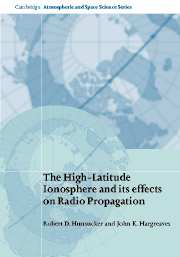Book contents
- Frontmatter
- Contents
- From the Times of London
- Preface
- Chapter 1 Basic principles of the ionosphere
- Chapter 2 Geophysical phenomena influencing the high-latitude ionosphere
- Chapter 3 Fundamentals of terrestrial radio propagation
- Chapter 4 Radio techniques for probing the ionosphere
- Chapter 5 The high-latitude F region and the trough
- Chapter 6 The aurora, the substorm, and the E region
- Chapter 7 The high-latitude D region
- Chapter 8 High-latitude radio propagation: part 1 – fundamentals and early results
- Chapter 9 High-latitude radio propagation: part 2 – modeling, prediction, and mitigation of problem
- Appendix: some books for general reading
- Index
Chapter 1 - Basic principles of the ionosphere
Published online by Cambridge University Press: 02 December 2009
- Frontmatter
- Contents
- From the Times of London
- Preface
- Chapter 1 Basic principles of the ionosphere
- Chapter 2 Geophysical phenomena influencing the high-latitude ionosphere
- Chapter 3 Fundamentals of terrestrial radio propagation
- Chapter 4 Radio techniques for probing the ionosphere
- Chapter 5 The high-latitude F region and the trough
- Chapter 6 The aurora, the substorm, and the E region
- Chapter 7 The high-latitude D region
- Chapter 8 High-latitude radio propagation: part 1 – fundamentals and early results
- Chapter 9 High-latitude radio propagation: part 2 – modeling, prediction, and mitigation of problem
- Appendix: some books for general reading
- Index
Summary
Introduction
The ionosphere and radio-wave propagation
The ionosphere is the ionized component of the atmosphere, comprising free electrons and positive ions, generally in equal numbers, in a medium that is electrically neutral. Though the charged particles are only a minority amongst the neutral ones, they nevertheless exert a great influence on the electrical properties of the medium, and it is their presence that brings about the possibility of radio communication over large distances by making use of one or more ionospheric reflections.
The early history of the ionosphere is very much bound up with the development of communications. The first suggestions that there are electrified layers within the upper atmosphere go back to the nineteenth century, but the modern developments really started with Marconi's well-known experiments in trans- Atlantic communication (from Cornwall to Newfoundland) in 1901. These led to the suggestions by Kennelly and by Heaviside (made independently) that, because of the Earth's curvature, the waves could not have traveled directly across the Atlantic but must have been reflected from an ionized layer. The name ionosphere came into use about 1932, having been coined by Watson-Watt several years previously. Subsequent research has revealed a great deal of information about the ionosphere: its vertical structure, its temporal and spatial variations, and the physical processes by which it is formed and which influence its behavior.
- Type
- Chapter
- Information
- Publisher: Cambridge University PressPrint publication year: 2002
- 1
- Cited by



